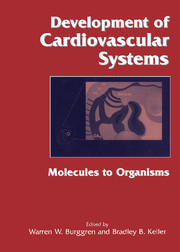Book contents
- Frontmatter
- Contents
- List of contributors
- Foreword by Constance Weinstein
- Introduction: Why study cardiovascular development?
- Part I Molecular, cellular, and integrative mechanisms determining cardiovascular development
- Part II Species diversity in cardiovascular development
- 9 Evolution of cardiovascular systems: Insights into ontogeny
- 10 Morphogenesis of vertebrate hearts
- 11 Invertebrate cardiovascular development
- 12 Piscine cardiovascular development
- 13 Amphibian cardiovascular development
- 14 Reptilian cardiovascular development
- 15 Avian cardiovascular development
- 16 Mammalian cardiovascular development: Physiology and functional reserve of the fetal heart
- Part III Environment and disease in cardiovascular development
- Epilogue: Future directions in developmental cardiovascular sciences
- References
- Systematic index
- Subject index
16 - Mammalian cardiovascular development: Physiology and functional reserve of the fetal heart
from Part II - Species diversity in cardiovascular development
Published online by Cambridge University Press: 10 May 2010
- Frontmatter
- Contents
- List of contributors
- Foreword by Constance Weinstein
- Introduction: Why study cardiovascular development?
- Part I Molecular, cellular, and integrative mechanisms determining cardiovascular development
- Part II Species diversity in cardiovascular development
- 9 Evolution of cardiovascular systems: Insights into ontogeny
- 10 Morphogenesis of vertebrate hearts
- 11 Invertebrate cardiovascular development
- 12 Piscine cardiovascular development
- 13 Amphibian cardiovascular development
- 14 Reptilian cardiovascular development
- 15 Avian cardiovascular development
- 16 Mammalian cardiovascular development: Physiology and functional reserve of the fetal heart
- Part III Environment and disease in cardiovascular development
- Epilogue: Future directions in developmental cardiovascular sciences
- References
- Systematic index
- Subject index
Summary
Functional adaptations of fetal ventricles
Embryonic and fetal circulations
As cardiac myocytes differentiate, they take on the well-described characteristics of striated muscle that underlie the function of the newly formed heart (Faber, Green, & Thornburg, 1974; Keller, Hu, & Tinney 1994). Thus, as shown in previous chapters, the embryonic heart displays many functional features in common with the fully mature heart. The embryonic mammalian heart becomes a four-chambered muscular pump at the completion of the cardiac septation stage and remains so throughout the animal's life. However, from the time of septation, the right and left ventricles operate as parallel pumps in the embryo and fetus to accommodate use of the placenta as the organ for nutrient and gas exchange for the duration of prenatal life.
Because the fetus depends on the placenta for oxygen acquisition, a significant portion of the cardiac output must pass through the placenta for gas exchange. Freshly oxygenated blood must then be distributed to vital organs. The fetal lungs obviously cannot be used for oxygenation before birth, and accordingly, they receive only a small fraction of the cardiac output (Heymann, Creasy, & Rudolph, 1973). The intrauterine circulatory arrangement is similar to the adult circulation but has four unique shunts: (1) placenta, (2) ductus venosus, (3) foramen ovale, and (4) ductus arteriosus (Figure 16.1). Blood from the fetal body is delivered to the placenta via a pair of umbilical arteries. In most species (the guinea pig is an exception), the oxygenated umbilical vein blood enters the fetal inferior vena cava at the site of the liver by passing through the ductus venosus.
- Type
- Chapter
- Information
- Development of Cardiovascular SystemsMolecules to Organisms, pp. 211 - 224Publisher: Cambridge University PressPrint publication year: 1998



